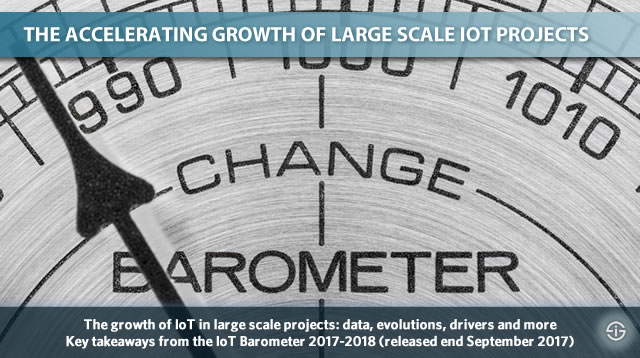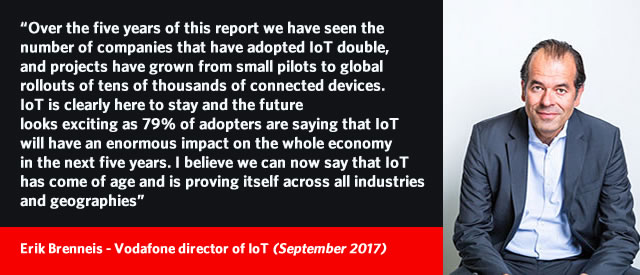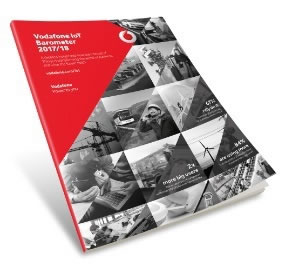A look at the drivers, key markets, benefits and challenges with regards to large scale Internet of Things (IoT) projects as found in the Vodafone IoT Barometer 2017/2018 report, released end 2017.
As adoption of the Internet of Things grows the number of scalable and large IoT projects is increasing rapidly. End 2016, IDC reported how organizations are moving beyond IoT pilot projects towards scalable Internet of Things deployments.
Scalable, large and more mature IoT projects are particularly found in industrial markets and applications whereby manufacturing, transportation and utilities for now continue to take the lead from the IoT investment and spending perspective, the Internet of Things in manufacturing ranking first.
The growth in large scale IoT projects also shows in the fifth edition of the IoT Barometer report; the Vodafone IoT Barometer 2017/2018. According to the report, which was released end September 2017, the number of such “massive scale” IoT projects has doubled in the last year.

Large IoT projects in the scope of the IoT Barometer 2017/2018
On top of the need to dive deeper into which industries and IoT use cases account for this doubling of such large scale IoT projects and the reasons why organizations launch them it’s of course important to know what the IoT Barometer 2017/2018 means with a large scale IoT project.
While IDC looks at scalable IoT deployments in the true sense of scalability, whereby cloud, analytics and security capabilities are incorporated, the IoT Barometer 2017/2018 expresses large scale IoT projects in terms of the number of connected devices: more than 50,000 connected devices to be precise (note that strictly speaking a connected device is not an IoT device).
So, when the IoT Barometer 2017/18 report says that the number of large scale IoT projects has doubled over the last 12 months it means that the percentage of organizations with over 50,000 of connected devices in action has doubled.
The reason why we mention this is because of the fact that several of the most transformational IoT projects go outside the borders of the individual organization. It’s one of the reasons why there is such a strong focus on IoT data sharing platforms and why there are initiatives such as Industrial Data Space whereby the goal is to bring together companies and other stakeholders who want to connect IoT and smart services to set up scalable IoT projects via a universal and secure data exchange reference architecture for Industry 4.0 and the Industrial Internet of Things across several areas such as life sciences and more. It is probably also one of the reasons why at the occasion of its June 2017 forecasts on IoT in the period 2017-2021, IDC emphasized that the discussion moved away from the number of connected devices.
Just as IoT connects, scalable and transformational IoT projects connect as well , across platforms, various stakeholders, ecosystems and so forth. That’s where the real value resides.
IoT has a key role in digital transformation
Still, the fact that the percentage of IoT projects with more than 50,000 involved devices has doubled in the 12 months preceding the survey for the IoT Barometer 2017/2018 as reported on September 27th 2017, a is impressive.
Moreover, the focus on connected devices in the Vodafone IoT Barometer 2017/2018 is logical as the IoT Barometer Report is commissioned on behalf of Vodafone as you already guessed, which mainly plays in the IoT technology layer of IoT connectivity and communication networks (more particular in wireless IoT).

Earlier in 2017, Vodafone announced that it is the first IoT mobile providers to have over 50 million connections and especially saw strong growth in this regard in automotive, healthcare and utilities. At the occasion of this 50 million connections announcement the company referred to the previous edition of its IoT Barometer (2016) which, among others, found that 48 percent of IoT adopters stated to be ready for the use of IoT in order to support large-scale business transformation and that 76 percent of businesses state that IoT will be critical for the future success of any organization within their particular sector.
The importance of IoT for digital transformation is confirmed in the IoT Barometer 2017/2018 as 66 percent of responding companies agree that without IoT digital transformation is impossible.
Large IoT projects 2017-2018: the industries, benefits, regional differences, hurdles and evolutions
Below are a few more findings – with comments – from the announcement of the Vodafone IoT Barometer report 2017/2018, conducted by Circle Research on behalf of Vodafone in 13 countries with a total of 1,278 executive respondents.
Large IoT projects: the industry perspective
The largest IoT projects globally (again, not from a spending but from a device perspective) are found in energy and utility companies.

In these industries, smart metering and pipeline monitoring are key IoT applications. As mentioned above other industries, however, are showing significant growth according to earlier statements by Vodafone: IoT in healthcare and IoT in automotive are among them. Let’s also not forget that there is significant growth in cross-industry IoT projects and use cases.
Large IoT projects: a tale of differing IoT benefits
From an IoT benefit viewpoint, 51 percent of IoT adopters claim that IoT increases revenues or opens up new revenue streams. Moreover, the range of IoT benefits is broadening, hand in hand with increasing adoption.
The saying that the proof of the pudding is in the eating comes to mind with eating in this case being testing, defining IoT strategies and rolling out. Globally, the top 3 of reported IoT benefits consists of greater business insights, reduced costs and improved employee productivity. Respondents from the Asia Pacific region, however, see the main IoT benefit in increased market competitiveness which is one of the more mature goals. Respondents from the automative industry emphasize brand differentiation (in other words: IoT and technology as the way to differentiate in this particular segment for all the known reasons).
The scale of large IoT projects per region
The latter brings us to regional differences (there are obviously also differences per industry).
While 84 percent of IoT adopters say that their use of the Internet of Things has grown in the past 12 months, large scale IoT projects are predominantly found in the Americas where 19 percent of companies have over 10,000 connected devices. Second comes Europe with 13 percent and third the Asia Pacific region with 7 percent.
The challenges and return of large scale IoT projects
Among the main IoT challenges we see traditional challenges such as finding the right IoT partners, skills, IoT strategy and obviously security. Yet, with regards to IoT security, the IoT Barometer 2017/2018 found that in organizations with at least 10,000 connected devices in activity only 7 percent put security at the top of their concerns and challenges list and that there is an increase of staff security training, collaboration with IoT security experts and IT security expert recruitment.
Looking at the return on investment and overall results of large scale IoT projects we point you to the full report where more is said about this topic. According to the press release large scale users report some of the biggest business gains with 67 percent emphasizing significant returns from the use of IoT.
Large IoT projects on average use four different IoT network technologies
Last but not least, given the activities of Vodafone, there are of course also findings on IoT connectivity and network requirements.
It is pretty obvious that the more active devices in the IoT device layer and the more large scale IoT projects in the IoT application and business layers, the more other layers are impacted and help in realizing scalable IoT deployments. It’s not a coincidence that all layers are poised for growth, including the market of IoT platforms.
And of course there is no Internet of Things without a network and communication layer. Here the IoT Barometer 2017/2018 emphasizes that organizations look for a mix of connectivity solutions (as they should), driven by the context and the application, with network solutions from fixed line to LPWAN (low power wide area networks).
On average a large scale IoT project uses four different connectivity options with mobile network standards and Wi-Fi being most popular and an increasing attention for Narrowband IoT (NB-IoT/Cat-M2), where Vodafone drives the agenda, and LPWAN in new IoT projects.
With LPWAN Vodafone refers to cellular approaches such as the mentioned NB-IoT/Cat-M2 and LTE/Cat-1/Cat-M1 but also to non-cellular LPWAN wireless IoT protocols and standards such as LoRa, Sigfox and the likes.
More in the full report which you can download here. The IoT Barometer 2017/2018 offers additional insight, data and comments on particular findings by Analysys Mason.
Top image: Shutterstock – Copyright: trekandshoot – All other images are the property of their respective mentioned owners.

